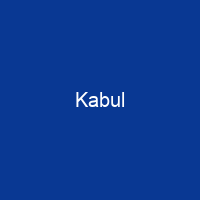Kabul: The Heart of Afghanistan
Imagine a city that has witnessed the rise and fall of empires, where history whispers through its narrow passageways and ancient gardens. Welcome to Kabul, the capital and largest city of Afghanistan, nestled in the Hindu Kush mountains. This metropolis is not just a place; it’s a living testament to centuries of human endeavor and resilience.
History Unfolds
Kabul’s story stretches back over 3,500 years, with dynasties like the Achaemenid Persians, Mughals, and British Empire leaving their marks. The name ‘Kabul’ itself is shrouded in mystery, with theories ranging from Persian words for straw and bridge to a Yuchi or Tukhari tribe’s legacy. Alexander Cunningham noted that Kaofu might be the name of this tribe, which gave its name to the city after occupation in the 2nd century BCE.
Fast forward through time, and Kabul became a major trading center under Timur (Tamerlane) and later part of the Mughal Empire. The city’s prominence grew significantly after Genghis Khan’s destruction of Kapisa in the 13th century. By the 19th century, it was known as the ‘Paris of Central Asia’ due to its hippie trail connections, drawing travelers from around the world.
Modern Challenges and Triumphs
The city’s history is marked by both glory and strife. From the Soviet invasion in 1979 to the Taliban takeover in 2021, Kabul has seen its share of turmoil. Yet, amidst these challenges, there have been moments of progress. King Habibullah Khan modernized Kabul with electricity, telephone, and postal service, establishing the first high school, Habibia, in 1903.
King Amanullah Khan announced Afghanistan’s independence at Eidgah Mosque in 1919 but his reforms were cut short after a local uprising. King Zahir Shah continued modernization efforts, including establishing Kabul University and developing infrastructure with the help of foreign nations like Japan, Germany, and Italy.
By the late 20th century, Kabul was known for its street sales of hashish and attracted Western hippies. The city’s population grew rapidly in the early 21st century, reaching over 3 million by 2023. Despite frequent terrorist attacks, Kabul continued to develop, with numerous modern housing complexes being built after the late 2000s.
Climate and Environment
Kabul’s climate is continental, cold semi-arid, with low humidity in summers and wet conditions in spring. Winters are very cold due to high elevation, while autumn features warm afternoons and cooler evenings. The Kabul River flows through the city, dividing central bazaars. A large lake called Kol-e Hashmat Khan was declared a protected area in 2017, providing a much-needed green space for residents.
Architecture and Culture
Kabul’s architecture reflects its rich history, with examples of Islamic and Mughal styles. The Gardens of Babur and the Id Gah Mosque are just two of many landmarks that showcase this heritage. Mausoleums like Abdul Rahman Mosque and Id Gah Mosque stand as testaments to the city’s past.
The city is also filled with cultural sites such as the National Museum of Afghanistan, Darul Aman Palace, and the tomb of Mughal Emperor Babur at Bagh-e Babur. Other places of interest include Kabul City Center, Wazir Akbar Khan district, Kabul Golf Club, and the National Gallery of Afghanistan.
Modern Developments
Kabul’s main products are fresh and dried fruit, nuts, beverages, rugs, leather products, furniture, antique replicas, and domestic clothes. The city has experienced rapid urbanization, with numerous modern housing complexes being built after the late 2000s. A high-security ‘Green Zone’ was formed in the center of the city, and a series of guarded checkpoints called the Ring of Steel were put into operation.
The Kabul New City project, a major residential scheme that would accommodate 1.5 million people, is set to break ground after a new contract was signed between the Ministry of Urban Development and Housing and Khawar Company in August 2023. The Qatar Township in Kabul is also planned to include 12 blocks with 768 flats, three business blocks, one mosque, two schools, and an orphanage.
Conclusion
Kabul, the heart of Afghanistan, continues to evolve amidst its rich history and modern challenges. From ancient empires to contemporary conflicts, this city has seen it all. As Kabul moves forward, it carries with it the lessons of its past, ready to embrace a brighter future.

You want to know more about Kabul?
This page is based on the article Kabul published in Wikipedia (retrieved on March 5, 2025) and was automatically summarized using artificial intelligence.







